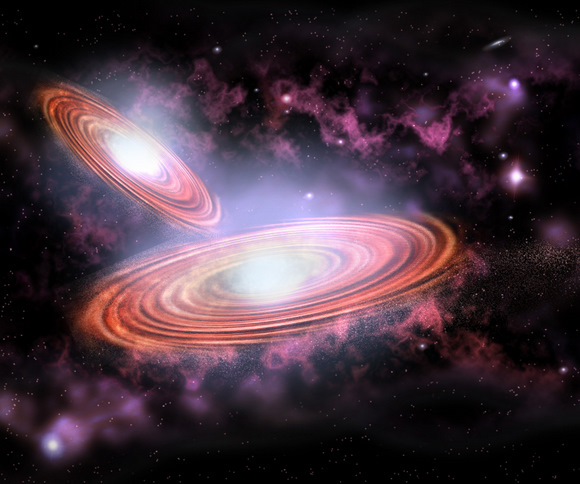It is estimated that in the process of merging galaxies, the black holes in their centers also merge, but this takes time and the scientists caught the event in its midst

Astronomers Todd Burrowson and Todd Lawer of the National Astronomical Optical Observatory (NOAO) in Tucson, Arizona, have discovered what appear to be two massive black holes orbiting each other at the center of a single galaxy. This discovery appeared in this week's issue of the journal Nature.
The astronomers suspected that in the largest galaxies, which are known to have a black hole at their center, and that most of the galaxies went through one or another process of mergers during their lifetime. But while double black hole systems may be common, they have proven difficult to detect. Boroson and Lower believe they have found a galaxy containing two black holes that orbit each other once every hundred years or so. They appear to be separated by only about a tenth of a persec (0.4 light-years), about a tenth of the distance from Earth to the nearest star.
After the galaxies were formed, it is likely that a massive black hole would form at their center. Because many galaxies are in clusters, individual galaxies can collapse and crash into each other as they orbit the cluster. The mystery is what happens to central black holes when galaxies collide and eventually merge. Theory predicts that they will circle each other and eventually merge into a larger black hole.
Previous studies have identified potential examples of black holes on the way to merging, but the current case is special because the pair of stars are close and the evidence is much stronger," writes John Miller, an astronomer at the University of Michigan in an editorial accompanying the article.
The two discovered the signature of the black holes, according to the emission lines of the materials that fail to fall into them. They discovered that two separate signatures came from the same source, the signatures they were looking for. The smaller of the two black holes has a mass of 20 million solar masses and the other is 50 times larger, as shown by their peripheral velocities.
The pair used data from the Sloan Digital Sky Scanner, a 2.5-meter diameter telescope in southern New Mexico to locate this signature among 17,500 quasars. As we know, quasars are actually active galaxies, which constantly fall material into the black hole at their center. So far, about one hundred thousand quasars have been discovered. First they ruled out the possibility that these are two separate galaxies, one of which happens to be hiding the other in our line of sight. They actually discovered that the two galaxies apparently have a similar reddening, and hence it is one galaxy.

9 תגובות
כ
A. Ben-Ner:
The discussion got skewed recently and I was dragged into saying something I didn't really mean.
I responded to the question that was asked and you - as if as part of the objection - asked a question about the waves created in a super nova event.
Today - since there are already several devices that try to detect gravitational waves that operate simultaneously and can verify among themselves the measurement of one-time and short events - there is a chance to discover waves created in a super nova event.
As mentioned - this is not the topic we were talking about.
These waves are - as mentioned, one-time events but they may be extremely powerful - something that can be likened to a tsunami in the sea. The reality of some devices may make up for the lack of periodicity.
A. Ben-Ner:
These waves - as I said - are a one-time phenomenon that passes quickly.
The chance of measuring them is zero.
To Michael R.
Yet,
What about measuring gravitational waves emitted from a supernova for example? Or from any one-time self-gravitational event?
A. Ben-Ner
I was not wrong.
The periodic gravity waves are created only as a result of a periodic phenomenon and their frequency is the same as the frequency of the phenomenon.
All non-periodic gravity occurs as a result of a non-periodic phenomenon and it passes and passes without again.
To Michael R.
I think you were wrong. If we had an effective device for focused measurement of gravitational waves, then it would be possible to measure the gravitational waves, which are caused and emitted as a result of the movement of the two black holes, despite the cycle time of about a hundred years of their mutual movement. After all, gravity waves are the curvature of space caused by the movement of the masses. The natural frequency of the gravity waves does not necessarily correspond to the rotation frequency of the masses.
As far as is known so far, gravitational waves have not yet been measured. I maintain that if they succeed in measuring gravitational waves, then it will be easier to measure the gravitational waves emitted from much closer sources, for example black holes in our galaxy or in nearby galaxies.
point:
These are guys far from each other who complete a cycle in 100 years.
This means that if there are gravitational waves at all that we can feel in the warps of space they create, it takes 100 years to feel them.
Therefore, obviously, there is no such figure at the moment.
I tend to believe that if and when such waves are discovered they will originate from black holes much closer to each other - ones that will surround each other within seconds - maximum.
Is there anything about gravitational waves?
Fascinating, thank you very much for the information